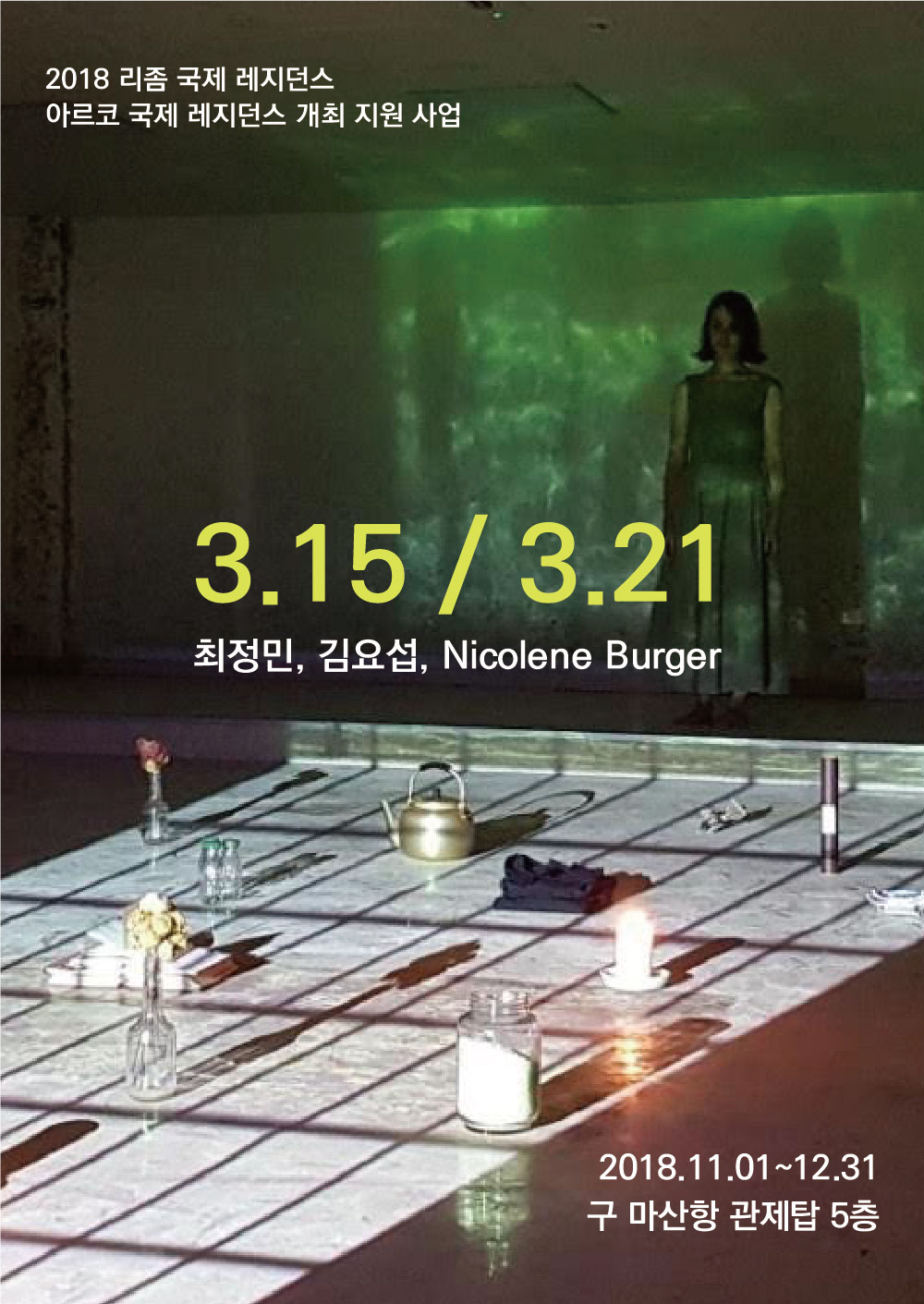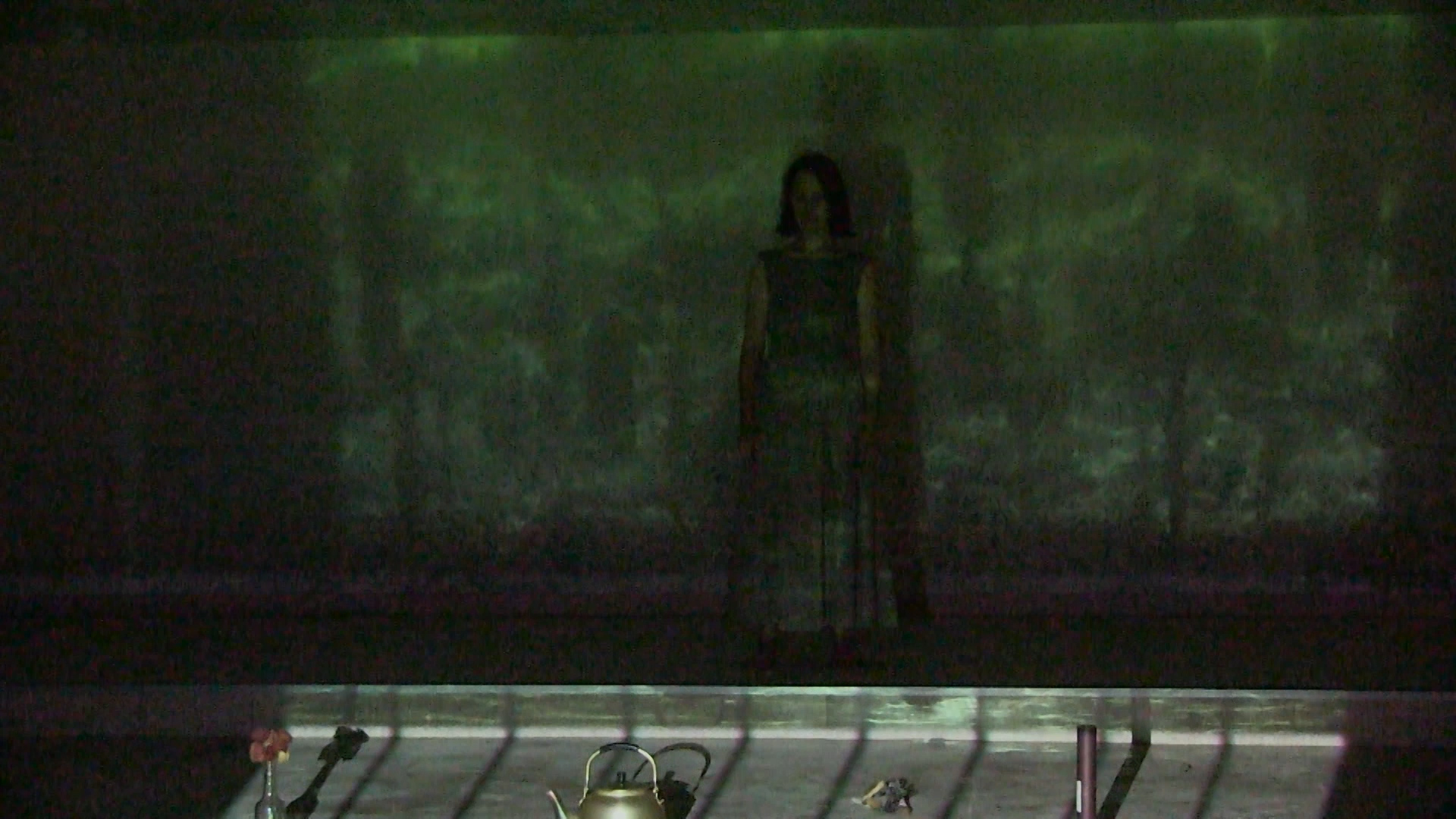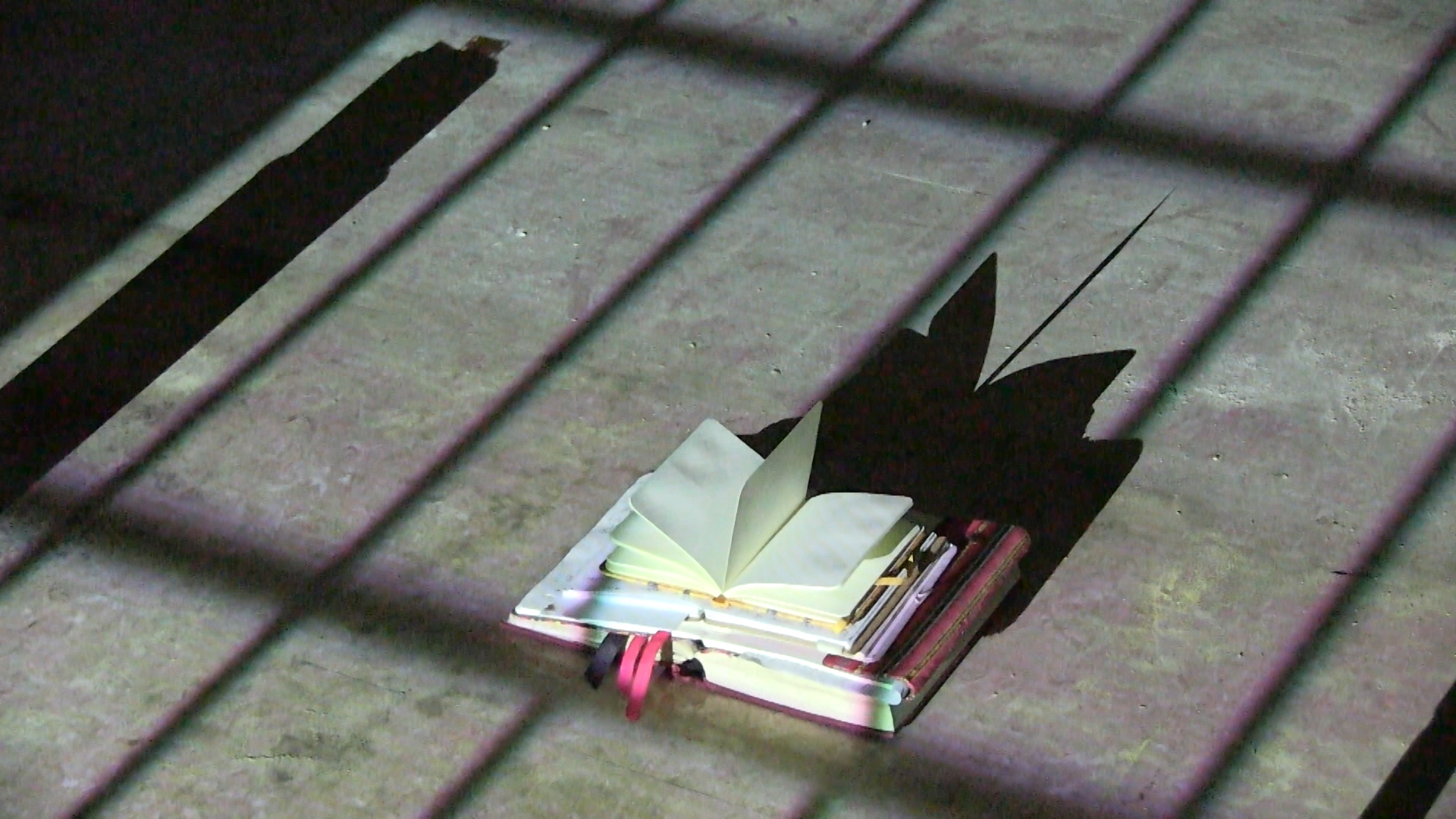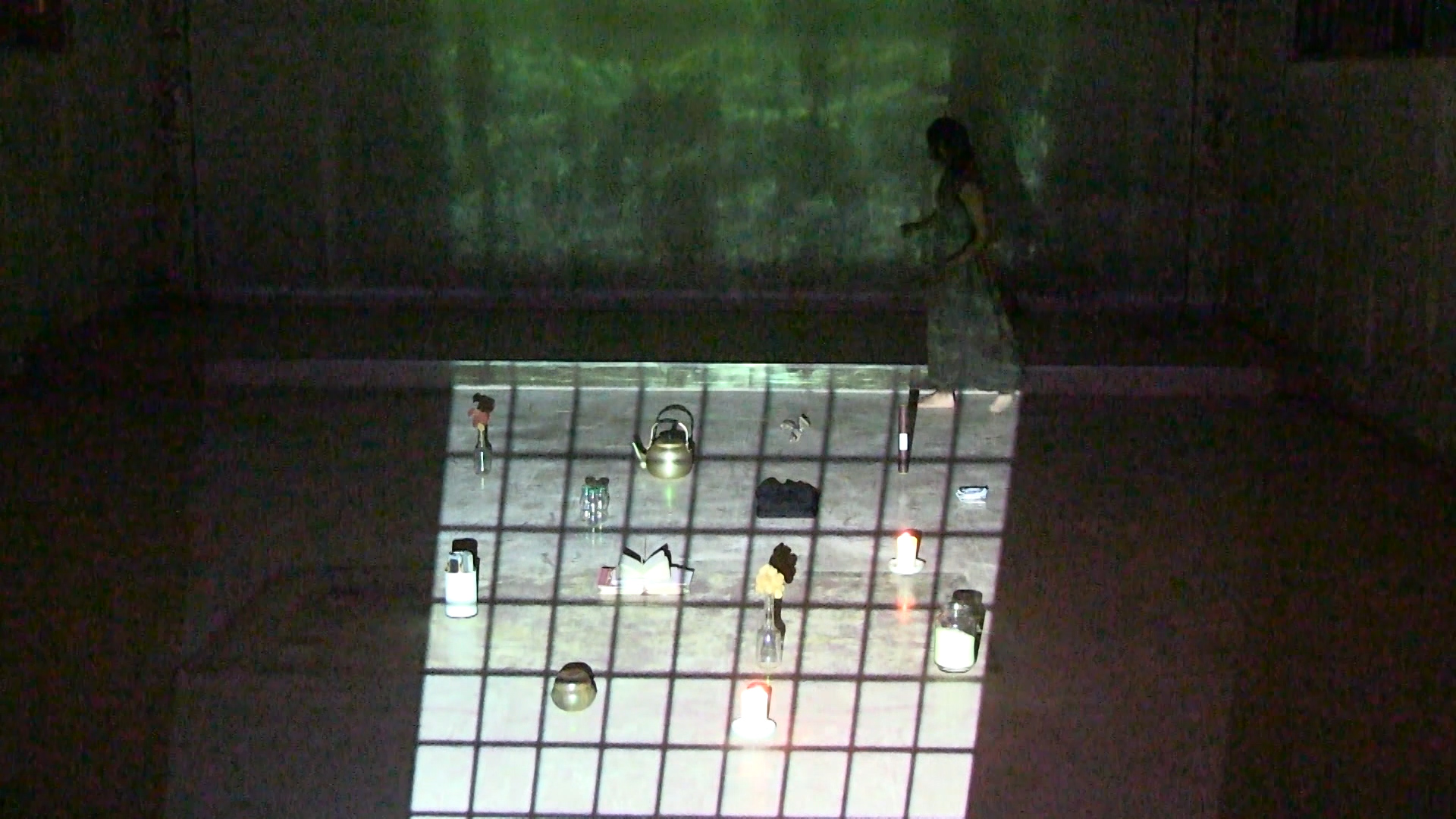전시
![]() HOME >
ACC프로젝트 >
전시
HOME >
ACC프로젝트 >
전시
[2018 창원 리좀 국제 레지던스] 니꿀린 베르게르, 최정민, 김요섭 '3·15/3·21'관리자작성일 18-11-01 00:00
[2018 창원 리좀 국제 레지던스]
니꿀린 베르게르, 최정민, 김요섭 '3·15/3·21'
작가 : 니꿀린 베르게르 Nicolene Burger, 최정민, 김요섭
전시기간 : 2018년 11월 01일 ~ 12월 31일
장소 : 구 마산항 관제탑 5층

'3·15/3·21' 영상
장르 : 단편영화
러닝타임 : 10분
배우 : 니꿀린 베르게르 Nicolene Burger
시나리오 : 김요섭
어시스턴트 : 신나래
통역 : 이은주
편집 : 최정민, 박영락
감독 : 최정민
1960년의 3·15와 남아공의 샤프빌 학살(3·21)은 다 른 공간에서 일어난 일이지만 비슷한 억압이 존재했 습니다. 이 공적 기억을 가로지르는 존재로 니꿀린은 특별한 의미가 있습니다. 개인사적 존재이자 기억의 오브제적 주체인 니꿀린이 3·15의 기억을 담은 오브 제를 기억의 스퀘어 속에 놓으면서 영화는 시작됩니 다. 각각의 오브제는 기억을 재현하는데 그것은 결국 마지막 스크린에서 공적 기억인 3·15와 3·21이 사적 기억인 니꿀린의 몸을 통과하면서 소소사와 공공사가 겹쳐지는 예술적 비디오로 구현하는 것이 컨셉입니다.
[오브제의 상징]
말벌집 : 활성화되지 않은 경우 집단 기억의 쇠퇴
노트북 열기 : 집단 기억의 유지를 위한 서면 개인 문서의 중요성
깨진 플레이트 : 문화 기억의 취약성
발효 냄비 : 집단 기억의 능동적 보존의 중요성
쌀병 : 죽은자에게 먹이를 주고, 그래서 현재의 담화 속에서 그들을 살아있게 하는 것의 중요성
건조한 장미 x2 : 돌아가신 친척들을 위한 부케 1배, 사미로와 샤프빌의 희생자들을 위한 부케 1배
도관 : 모든 사람들을 위한 무료 교육 또한 백인 특권의 상징이다.
이런식으로 남아공의 현재의 시위와 'Sharpeville과 새로운 남아프리카의 헌법'을 언급한다.
필름음성 : 집합적 기억을 위한 사진문서의 중요성
금주전자 : 창동과 시장 영역의 상징
양초 x2 : 지나간 사랑을 추모하는 촛불의 애도 의식, 나의 개인적인 추억을 위한 1배의 촛불, 사미로와 샤프빌의 희생자들을 위한 1배 촛불
유리병의 말벌 : 공동체의 취약성
교복 : 사미로
페인트 브러시 묶음 : 예술가들이 집단 기억의 보존과 문서화에 중요한 역할을 한다.
↓영상 보기




니꿀린 베르게르, 최정민, 김요섭 '3·15/3·21'
작가 : 니꿀린 베르게르 Nicolene Burger, 최정민, 김요섭
전시기간 : 2018년 11월 01일 ~ 12월 31일
장소 : 구 마산항 관제탑 5층

'3·15/3·21' 영상
장르 : 단편영화
러닝타임 : 10분
배우 : 니꿀린 베르게르 Nicolene Burger
시나리오 : 김요섭
어시스턴트 : 신나래
통역 : 이은주
편집 : 최정민, 박영락
감독 : 최정민
1960년의 3·15와 남아공의 샤프빌 학살(3·21)은 다 른 공간에서 일어난 일이지만 비슷한 억압이 존재했 습니다. 이 공적 기억을 가로지르는 존재로 니꿀린은 특별한 의미가 있습니다. 개인사적 존재이자 기억의 오브제적 주체인 니꿀린이 3·15의 기억을 담은 오브 제를 기억의 스퀘어 속에 놓으면서 영화는 시작됩니 다. 각각의 오브제는 기억을 재현하는데 그것은 결국 마지막 스크린에서 공적 기억인 3·15와 3·21이 사적 기억인 니꿀린의 몸을 통과하면서 소소사와 공공사가 겹쳐지는 예술적 비디오로 구현하는 것이 컨셉입니다.
[오브제의 상징]
말벌집 : 활성화되지 않은 경우 집단 기억의 쇠퇴
노트북 열기 : 집단 기억의 유지를 위한 서면 개인 문서의 중요성
깨진 플레이트 : 문화 기억의 취약성
발효 냄비 : 집단 기억의 능동적 보존의 중요성
쌀병 : 죽은자에게 먹이를 주고, 그래서 현재의 담화 속에서 그들을 살아있게 하는 것의 중요성
건조한 장미 x2 : 돌아가신 친척들을 위한 부케 1배, 사미로와 샤프빌의 희생자들을 위한 부케 1배
도관 : 모든 사람들을 위한 무료 교육 또한 백인 특권의 상징이다.
이런식으로 남아공의 현재의 시위와 'Sharpeville과 새로운 남아프리카의 헌법'을 언급한다.
필름음성 : 집합적 기억을 위한 사진문서의 중요성
금주전자 : 창동과 시장 영역의 상징
양초 x2 : 지나간 사랑을 추모하는 촛불의 애도 의식, 나의 개인적인 추억을 위한 1배의 촛불, 사미로와 샤프빌의 희생자들을 위한 1배 촛불
유리병의 말벌 : 공동체의 취약성
교복 : 사미로
페인트 브러시 묶음 : 예술가들이 집단 기억의 보존과 문서화에 중요한 역할을 한다.
↓영상 보기




3·15 / 3·21
- 니꿀린 베르게르
한국의 마산에 있는 ‘에스빠스 리좀’에서 국제 예술인 레지던시 프로그램에 참여한 나는 이 도시와 이 나라의 역사에서 중요한 정치적 사건을 어떻게 기억할 것인가라는 과업을 받았다. 그것은 현재 창동예술촌과 에스빠스 리좀이 있는 공간에서 1960년 3월 15일에 일어났던 항거이다. 이 항거는 부정선거에 반대하는 학생과 노동 집단들에 의해 주도된 것으로 ‘3·15의거’라 불리며 동년 ‘4월혁명’의 발단이 되었다. ‘4월혁명’은 이승만이 영도하던 한국의 권위적인 초대 공화국을 전복시켰다. 1960년 3월 15일 수 천 명의 마산 시민이 민주당사 앞에 모였다. 이 시위가 경찰과 데모대 간의 유혈 충돌로 끝난 후 이 항거가 전국적인 혁명의 불꽃을 일으키게 된 것은 1960년 4월 11일 마산만에서 발견된 김주열의 시체였다.
마산상고 학생이었던 김주열은 3·15의거 시위 과정에서 실종되었다. 그의 죽음의 원인이 익사라는 당시 당국의 발표에도 불구하고 많은 마산 시민들은 정부의 해명을 믿지 않았다. 시민들은 그의 시체가 안치된 병원으로 달려갔고 20센티 길이의 최루탄이 그의 오른쪽 눈에 박혀 있음을 보았다. 경찰이 시위대에게 치명상을 입힐 목적으로 최루탄을 직격으로 쏘았다는 사실이 엄청난 분노의 폭발을 설명해준다. 이 사건의 잔혹성과 이를 감추려는 이승만 정권의 시도는 마산을 3일간의 대규모 시위로 이끌어갔고, 경찰과 더 한층 격렬한 충돌이 유발되었고 시위는 나라 전체로 확산되었다. 이것이 ‘4월혁명’으로 불리는 사건의 개요다. 내 작업에서 개인적인 아카이브에 대한 염려와 기억의 과정 -만들기, 침식 및 기억의 진화– 에 대한 관심은 나를 자연스럽게 ‘예술적 실천에 대한 개인의 기억’에 관한 의문으로부터 공공 기억에 관한 간략한 탐구를 강조하는 질문으로 인도했고, 한국의 소설가 김요섭과 최정민 영화감독과의 협력을 통해 다음 질문들을 탐구했다. “예술가는 어떻게 집단적 기억의 공공적인 인스턴스를 창조하는 데 기여할 수 있을까” “우리는 어떻게 현 사회들에 존재하는 육체들과 공간들에서 여전히 공명하고 있는 불안정한 집단들의 역사를 밝힐 수 있을까 - 배제, 희생자 만들기와 차별의 역사를”
말할 것도 없이 이 질문들은 나로 하여금 다양한 방식으로 남아프리카공화국의 역사를 상기하게 만들었다. 그 후 3·15에 관한 연구를 시도했지만 나는 제한적인데다가 출처도 없는 영어로 된 2개의 자료밖에 발견할 수 없었다. 이러한 정치적 사건이 예술을 통해 기억되어야 한다는 데 깊이 동감하면서도 ‘어떻게’라는 질문에는 난감할 수밖에 없었다. 그것은 매체와 구성의 측면에서 본 하나의 예술 형식으로서의 ‘어떻게’가 아니라 개념적이고 정치적인 ‘어떻게’이다.
나는 내가 잘 모르는 외국의 역사를 놓고 대화하는 것이 얼마나 어려운 일인지 깨달았다. 내가 겪지 않은 역사는 그에 대해 다시 말하거나 의견을 제시하거나 행동하게 만들 수 없다. 이 불편한 인식은 이 사건에 대해 리좀 레지던시의 큐레이터가 반복해서 가르쳐준 것들과 함께 백인 아프리칸 예술가로서의 나의 역할과 책임에 대한 질문으로 이끌어갔다. 나는 나의 조국이 과거에 저지른 불의를 인정하는 공간을 창조하는 데 예술을 통해 어떻게 기여할 수 있을까? 화해로 이끌어갈 수 있는 공간 말이다. 나에게 이익이 되도록 만들어진 시스템이 야기한 폭력과 피해를 정직하게 발아들이면서? 과연 내가 기여할 수 있을까? 할 수 있다면 어떻게?
어쩌면 여기서 내가 할 수 있는 역할은 이 사건들은 너무나 중요해서 반드시 기억해야 한다는 것을 강조하는 데 그치지 않을까. 아마 나는 나의 실천과 내가 가진 모든 기회를 사용해야 할 것이다. 이 역사들이 나의 육체와 나의 작업에 작용할 수 있도록 만들기 위해서는 내가 그것들과 상호작용 하는 게 아니라 그것들이 나와 상호작용하도록 만들어야 할지도 모른다. 아마 이 질문들에 대해 바로 이 시점에서 남아프리카의 맥락 속에서 답하려고 애쓰고 있는 것은 나밖에 없을 것이다.
마산상고 학생이었던 김주열은 3·15의거 시위 과정에서 실종되었다. 그의 죽음의 원인이 익사라는 당시 당국의 발표에도 불구하고 많은 마산 시민들은 정부의 해명을 믿지 않았다. 시민들은 그의 시체가 안치된 병원으로 달려갔고 20센티 길이의 최루탄이 그의 오른쪽 눈에 박혀 있음을 보았다. 경찰이 시위대에게 치명상을 입힐 목적으로 최루탄을 직격으로 쏘았다는 사실이 엄청난 분노의 폭발을 설명해준다. 이 사건의 잔혹성과 이를 감추려는 이승만 정권의 시도는 마산을 3일간의 대규모 시위로 이끌어갔고, 경찰과 더 한층 격렬한 충돌이 유발되었고 시위는 나라 전체로 확산되었다. 이것이 ‘4월혁명’으로 불리는 사건의 개요다. 내 작업에서 개인적인 아카이브에 대한 염려와 기억의 과정 -만들기, 침식 및 기억의 진화– 에 대한 관심은 나를 자연스럽게 ‘예술적 실천에 대한 개인의 기억’에 관한 의문으로부터 공공 기억에 관한 간략한 탐구를 강조하는 질문으로 인도했고, 한국의 소설가 김요섭과 최정민 영화감독과의 협력을 통해 다음 질문들을 탐구했다. “예술가는 어떻게 집단적 기억의 공공적인 인스턴스를 창조하는 데 기여할 수 있을까” “우리는 어떻게 현 사회들에 존재하는 육체들과 공간들에서 여전히 공명하고 있는 불안정한 집단들의 역사를 밝힐 수 있을까 - 배제, 희생자 만들기와 차별의 역사를”
말할 것도 없이 이 질문들은 나로 하여금 다양한 방식으로 남아프리카공화국의 역사를 상기하게 만들었다. 그 후 3·15에 관한 연구를 시도했지만 나는 제한적인데다가 출처도 없는 영어로 된 2개의 자료밖에 발견할 수 없었다. 이러한 정치적 사건이 예술을 통해 기억되어야 한다는 데 깊이 동감하면서도 ‘어떻게’라는 질문에는 난감할 수밖에 없었다. 그것은 매체와 구성의 측면에서 본 하나의 예술 형식으로서의 ‘어떻게’가 아니라 개념적이고 정치적인 ‘어떻게’이다.
나는 내가 잘 모르는 외국의 역사를 놓고 대화하는 것이 얼마나 어려운 일인지 깨달았다. 내가 겪지 않은 역사는 그에 대해 다시 말하거나 의견을 제시하거나 행동하게 만들 수 없다. 이 불편한 인식은 이 사건에 대해 리좀 레지던시의 큐레이터가 반복해서 가르쳐준 것들과 함께 백인 아프리칸 예술가로서의 나의 역할과 책임에 대한 질문으로 이끌어갔다. 나는 나의 조국이 과거에 저지른 불의를 인정하는 공간을 창조하는 데 예술을 통해 어떻게 기여할 수 있을까? 화해로 이끌어갈 수 있는 공간 말이다. 나에게 이익이 되도록 만들어진 시스템이 야기한 폭력과 피해를 정직하게 발아들이면서? 과연 내가 기여할 수 있을까? 할 수 있다면 어떻게?
어쩌면 여기서 내가 할 수 있는 역할은 이 사건들은 너무나 중요해서 반드시 기억해야 한다는 것을 강조하는 데 그치지 않을까. 아마 나는 나의 실천과 내가 가진 모든 기회를 사용해야 할 것이다. 이 역사들이 나의 육체와 나의 작업에 작용할 수 있도록 만들기 위해서는 내가 그것들과 상호작용 하는 게 아니라 그것들이 나와 상호작용하도록 만들어야 할지도 모른다. 아마 이 질문들에 대해 바로 이 시점에서 남아프리카의 맥락 속에서 답하려고 애쓰고 있는 것은 나밖에 없을 것이다.
그래서 나는 당장 이 질문들에 답하는 대신 이 한국의 시위가 1960년에 남아프리카 샤프빌에서 일어났던 학살에 불과 6일 전에 일어났다는 사실을 기억해냈고, 우리는 공동 작업을 여기에 초점을 맞추기로 했다.
<3·15/3·21: 사물의 기억>이라는 제목 하에 나는 최정민 감독과 김요섭 작가와 함께 공공의 기억과 개인의 기억이 어떻게 상호교차 하는지 그리고 이러한 교차가 복잡하고 충격적인 공공적 사건들에 관한 작품을 창조함에 있어 예술가들에게 무엇을 제공할 수 있을지를 탐구했다. 즉 공적 역사가 어떻게 사적 공간에 있는 사물에 투사되는가를 탐구한 것이다. 스텔렌보쉬 대학교(University of Stellenbosch) 학위 증명서와 같은 사물들을 투사된 격자창 속에 놓음으로써 포스트 아파르트헤이트 남아공화국에서의 자유 교육이 가진 문제점을 부각시키고, 나의 대학 입학은 백인이 가진 특권을 상징한다는 사실을 지적했다. 이 작품에서 간단한 액션을 반복함으로써 앞서 언급된 “어떻게”라는 질문을 각성하고자 했다. 이는 집단적 기억의 고찰에서 ‘어떻게’에 관한 탐구가 가진 중요성을 예시해준다.
<3·15/3·21: 사물의 기억>이라는 제목 하에 나는 최정민 감독과 김요섭 작가와 함께 공공의 기억과 개인의 기억이 어떻게 상호교차 하는지 그리고 이러한 교차가 복잡하고 충격적인 공공적 사건들에 관한 작품을 창조함에 있어 예술가들에게 무엇을 제공할 수 있을지를 탐구했다. 즉 공적 역사가 어떻게 사적 공간에 있는 사물에 투사되는가를 탐구한 것이다. 스텔렌보쉬 대학교(University of Stellenbosch) 학위 증명서와 같은 사물들을 투사된 격자창 속에 놓음으로써 포스트 아파르트헤이트 남아공화국에서의 자유 교육이 가진 문제점을 부각시키고, 나의 대학 입학은 백인이 가진 특권을 상징한다는 사실을 지적했다. 이 작품에서 간단한 액션을 반복함으로써 앞서 언급된 “어떻게”라는 질문을 각성하고자 했다. 이는 집단적 기억의 고찰에서 ‘어떻게’에 관한 탐구가 가진 중요성을 예시해준다.
3·15 / 3·21
-Nicolene Burger
Working as part of the International Artist Residency Program at Espace Rhizome in Masan South Korea, I was tasked to remember, through my work, an important political event in the city and country's history. This is, the protest that happened on the 15th of March 1960, in the area that is now Changdong Art Town and the location of Espace Rhizome. This protest, against electoral corruption led by labour and student groups, is often referred to as just 3·15 (March, 15) and formed the basis of the April Revolution in the same year, which overthrew the autocratic First Republic of South Korea under Syngman Rhee.
On March 15, 1960, over a thousand residents of Masan gathered in protest against the Democratic Party Headquarters in Masan.
After this demonstration ended in a violent clash between police and protesters, what drove this protest to spark a national revolution, was the discovery of Kim Ju-yul's body in the harbor of Masan, on the 11th of April, 1960.
Kim, a student at Masan Commercial High School, disappeared during the 3·15 protest and despite an announcement by the authorities at the time that the cause of his death was drowning, many citizens of Masan rejected this explanation. Some protesters forced their way into the hospital where his body was kept and found that Kim's skull had been split by a 20 centimeter long tear gas grenade. The severity of the explosion indicated that the police had shot the tear gas grenade with the purpose of being fatal- directly into Kim’s face. The brutality of this incident and the attempt to censor its happening by Rhee’s regime, caused Masan to erupted into three days of mass protests which led to further violent clashes with the police and rippled through the country, which became known as the April Revolution.
On March 15, 1960, over a thousand residents of Masan gathered in protest against the Democratic Party Headquarters in Masan.
After this demonstration ended in a violent clash between police and protesters, what drove this protest to spark a national revolution, was the discovery of Kim Ju-yul's body in the harbor of Masan, on the 11th of April, 1960.
Kim, a student at Masan Commercial High School, disappeared during the 3·15 protest and despite an announcement by the authorities at the time that the cause of his death was drowning, many citizens of Masan rejected this explanation. Some protesters forced their way into the hospital where his body was kept and found that Kim's skull had been split by a 20 centimeter long tear gas grenade. The severity of the explosion indicated that the police had shot the tear gas grenade with the purpose of being fatal- directly into Kim’s face. The brutality of this incident and the attempt to censor its happening by Rhee’s regime, caused Masan to erupted into three days of mass protests which led to further violent clashes with the police and rippled through the country, which became known as the April Revolution.
The preoccupation with the personal archive in my work and the interest in processes of memory- the making, erosion and evolution of memory- has naturally led me from questions around ‘personal remembrance in art practice’, to the research questions that underlines this brief study of public remembrance, in collaboration with the South Korean Novelist, Kim Yoseob and Film Director, J. Min. These questions being:“How can artists add to the creation of public instances of collective remembering?” “How do we highlight histories of precarious groups that still resonate in bodies and space present in our societies- the histories of exclusion, victimization and discrimination?” Without saying, these questions brought me to South African history in more than one way. Since, in trying to research 3·15, I was not only confronted by the inability of finding more than two limited, unreferenced English sources; I was also, despite being deeply convinced that political incidents like this one should be remembered through art, confronted with the question of how? Not is an art formal ‘how’ in terms of medium, composition etc., but in a conceptual and political ‘how’.
find it difficult to negotiate the speaking of a history to which I am an outsider, a history which might not be my story to retell, comment on or enact. This uncomfortable awareness together with the repeated instruction from the residency curator to remember this event, led to questions about my role and responsibility as a white Afrikaans artist. How can I contribute, through art, in creating spaces that recognised the the injustices that forms my country’s past? Spaces that can lead to reconciliation, while still honestly admitting the violence and damage brought about by a system created in my favor? Is it at all possible for me to contribute and if so, how?
find it difficult to negotiate the speaking of a history to which I am an outsider, a history which might not be my story to retell, comment on or enact. This uncomfortable awareness together with the repeated instruction from the residency curator to remember this event, led to questions about my role and responsibility as a white Afrikaans artist. How can I contribute, through art, in creating spaces that recognised the the injustices that forms my country’s past? Spaces that can lead to reconciliation, while still honestly admitting the violence and damage brought about by a system created in my favor? Is it at all possible for me to contribute and if so, how?
Maybe my role at this point should be just to underline these events as important to remember- maybe not even that? Maybe I should use my practice and every opportunity I have to let these histories play over my body and work, to let it interact with me and not me with it? Maybe I am not the one that should be trying to answer these questions in the South African context at this moment in time?
So, instead of answering these question in the very short period I was given to remember this South Korean protest (that took place only six days before the South African Sharpeville Massacre of 1960), we just paused in this collaborations at these questions.
Under the title, 3·15/3·21: Memory of Objects , J.Min, Kim Yoseob and I investigate how public and personal memory intersect and what this intersection might offer artists in creating works about complicated, traumatic public events. We focused on how public history is projected onto objects in the private space.
By placing objects such as a degree certificate from the University of Stellenbosch, amongst other things, in a projected grid, we call to attention the problem of free education in Post-Apartheid South Africa. While also pointing to the fact that access to a university is a symbol of my white privilege.
Simple repeated actions are used in this piece to bring prominence to the “how” question mentioned above- illustrating the importance of asking “how” in considerations of remembering on behalf of, or as a collective.
So, instead of answering these question in the very short period I was given to remember this South Korean protest (that took place only six days before the South African Sharpeville Massacre of 1960), we just paused in this collaborations at these questions.
Under the title, 3·15/3·21: Memory of Objects , J.Min, Kim Yoseob and I investigate how public and personal memory intersect and what this intersection might offer artists in creating works about complicated, traumatic public events. We focused on how public history is projected onto objects in the private space.
By placing objects such as a degree certificate from the University of Stellenbosch, amongst other things, in a projected grid, we call to attention the problem of free education in Post-Apartheid South Africa. While also pointing to the fact that access to a university is a symbol of my white privilege.
Simple repeated actions are used in this piece to bring prominence to the “how” question mentioned above- illustrating the importance of asking “how” in considerations of remembering on behalf of, or as a collective.

 전체
전체 2018
2018